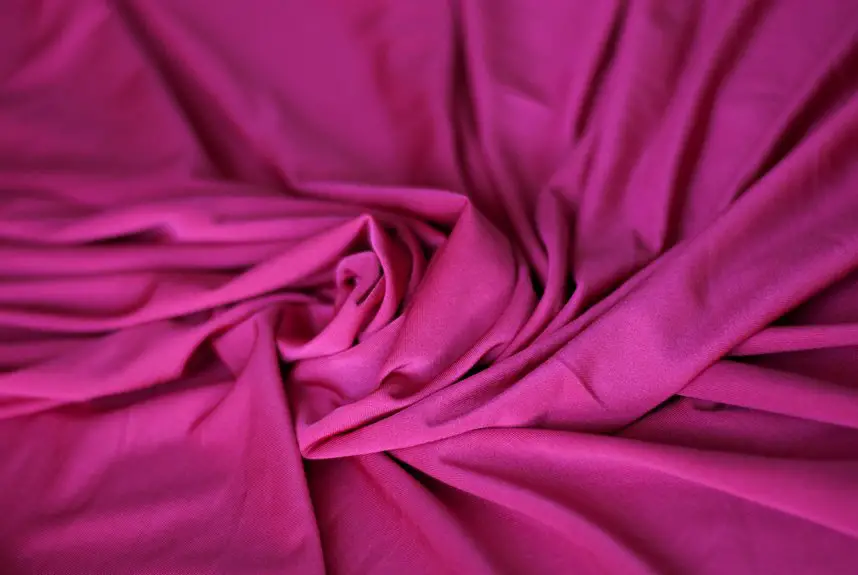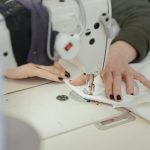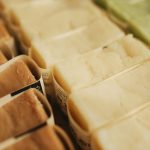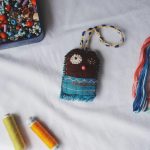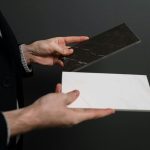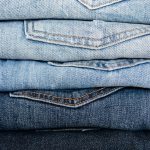You can tell if fabric is woven or nonwoven by looking closely at its structure. Woven fabrics have yarns crossing at right angles, creating a clear, grid-like pattern and feel sturdy with little stretch. Nonwoven fabrics lack this pattern—they look random and feel soft or fuzzy, often stretching unevenly. You might also try a burn test to notice differences in how they burn and smell. Keep exploring to discover the best ways to identify and choose the right fabric for your needs.
Table of Contents
Key Takeaways
- Woven fabrics have a grid-like pattern of interlaced yarns, while nonwovens display a random, felt-like surface without thread patterns.
- When stretched, woven fabrics resist distortion due to locked yarns, whereas nonwovens may stretch unevenly or deform.
- Woven fabrics feel smooth and structured, but nonwovens feel irregular or fuzzy from bonded fibers.
- Burn test: woven fabric burns slower with a smell like burning thread, while nonwovens burn quickly and may melt or produce chemical odors.
- Woven fabrics allow some light passage through the weave, whereas nonwovens appear denser and block more light.
Understanding the Basic Structure of Woven Fabrics
Although woven fabrics come in many varieties, they all share a basic structure made by interlacing two sets of yarns at right angles.
All woven fabrics share a fundamental design: two yarn sets interlaced at right angles.
When you look closely, you’ll see the lengthwise yarns, called the warp, running vertically, while the crosswise yarns, known as weft, run horizontally. This crisscross pattern creates a stable, strong fabric that doesn’t stretch much unless it includes elastic fibers.
As you handle woven fabric, you’ll notice the yarns are firmly locked together, giving the material its shape and durability. You can often spot the weave pattern—plain, twill, or satin—by examining how the yarns cross over and under each other.
Understanding this structure helps you identify woven fabric and distinguish it from other types.
Characteristics That Define Nonwoven Fabrics
While woven fabrics rely on interlacing yarns, nonwoven fabrics take a different approach by bonding fibers together without weaving or knitting.
When you examine nonwovens, you’ll notice they’re made from loose fibers held together through methods like heat, chemicals, or mechanical entanglement. This structure gives them unique traits: they’re often lightweight, flexible, and can have varied thicknesses.
You’ll find nonwovens don’t unravel like woven fabrics because they lack a distinct thread pattern. Also, they usually have a uniform appearance without visible yarns running in specific directions.
Their strength depends on fiber type and bonding technique rather than yarn tension. Understanding these characteristics helps you identify nonwoven fabrics and appreciate their versatility in everything from medical supplies to filters.
Visual Inspection Techniques for Fabric Identification
When you look closely at a fabric, certain visual cues can quickly tell you if it’s woven or nonwoven. Woven fabrics display a clear, repeating pattern of interlaced threads running perpendicular to each other. You’ll notice distinct warp and weft yarns forming a grid-like structure.
Nonwovens, on the other hand, lack this organized pattern. Instead, you’ll see a random, felt-like surface or a uniform web of fibers without clear crossing lines.
Hold the fabric up to the light; woven fabrics often allow light to pass through the spaces between yarns, while nonwovens generally appear denser or more opaque.
You can also gently pull the fabric—woven fabrics resist stretching across the grain, but nonwovens may stretch or tear more unevenly.
These visual and tactile checks help you identify fabric types quickly.
The Role of Fiber Arrangement in Fabric Types
Because fiber arrangement determines a fabric’s structure and performance, understanding it’s key to distinguishing woven from nonwoven materials.
When you look at woven fabrics, you’ll see fibers interlaced at right angles, forming a clear pattern of warp and weft threads. This organized layout gives woven fabrics strength and durability.
Nonwoven fabrics, on the other hand, have fibers randomly oriented and bonded together through heat, pressure, or adhesives. This lack of a defined pattern makes nonwovens less structured but more flexible and often disposable.
How to Perform a Burn Test to Differentiate Fabrics
To perform a burn test, start by preparing small fabric samples in a safe, well-ventilated area.
Watch how the fabric burns, noting the flame behavior, speed, and smell.
Finally, analyze the leftover residue to help identify whether the fabric is woven or nonwoven.
Preparing Fabric Samples
Although fabric samples may look similar at first glance, performing a burn test can reveal whether they’re woven or nonwoven.
To prepare your fabric samples for the burn test, you’ll want to follow these steps carefully:
- Cut a small piece, about 1 inch square, from the fabric to guarantee safety and manageability.
- Place the sample on a non-flammable surface like a metal tray or ceramic plate.
- Keep a pair of tweezers handy to hold the fabric securely without burning your fingers.
- Have a source of flame ready, such as a lighter or candle, and make sure you’re in a well-ventilated area away from flammable materials.
These preparations will help you perform the burn test safely and effectively.
Observing Burn Behavior
How can you tell if a fabric is woven or nonwoven just by watching it burn? Start by holding a small fabric sample with tweezers over a flame in a well-ventilated area.
Woven fabrics, made from interlaced yarns, tend to burn steadily, often curling away from the flame. Nonwoven fabrics, composed of bonded fibers, usually burn faster and may melt or shrink irregularly.
Watch for how the edges react—woven fabrics often leave a crisp edge, while nonwovens can fuse or clump. Keep the sample in the flame briefly, then remove it to observe how the burn continues.
This direct observation helps you distinguish the structural differences between woven and nonwoven fabrics based on their combustion behavior. Always exercise caution when performing burn tests.
Analyzing Residue and Smell
When you perform a burn test, paying close attention to the residue and smell can reveal whether a fabric is woven or nonwoven.
After the fabric burns, observe these key details:
- Residue Texture: Woven fabrics often leave behind hard, grainy ash; nonwovens usually produce a softer, crumbly residue.
- Residue Color: Woven cotton leaves gray ash, while synthetic nonwovens might leave a melted, plastic-like residue.
- Smell: Woven natural fibers smell like burning paper or leaves; nonwovens, especially synthetics, emit a chemical or plastic odor.
- Residue Shape: Woven fabric ash tends to hold a shape; nonwoven ash often crumbles easily.
Texture and Feel Differences Between Woven and Nonwoven
Texture plays a key role in distinguishing woven fabrics from nonwoven ones. When you touch woven fabrics, you’ll notice a structured, often smoother feel due to the interlaced yarns. Nonwoven fabrics, however, feel more irregular or fuzzy since fibers are bonded rather than woven. This difference helps you quickly identify the fabric type by feel alone.
| Feature | Woven Fabrics |
|---|---|
| Feel | Smooth, structured |
| Surface Texture | Even, consistent |
| Fiber Bonding | Interlaced yarns |
| Feature | Nonwoven Fabrics |
| Feel | Irregular, sometimes rough |
| Surface Texture | Fuzzy, uneven |
| Fiber Bonding | Fibers pressed or glued |
This tactile contrast guides you in fabric identification without tools.
Stretch and Flexibility Tests for Fabric Analysis
Although woven and nonwoven fabrics may look similar at first glance, their stretch and flexibility reveal key differences. You can easily test these qualities to identify the fabric type.
First, gently pull the fabric along the grain; woven fabrics tend to stretch less because of their interlaced yarns.
Second, try stretching it diagonally; woven fabrics often have more give this way due to their weave pattern.
Third, compress the fabric between your fingers to check flexibility—nonwovens usually feel more pliable and less structured.
Fourth, twist the fabric to see how it recovers; woven fabrics generally bounce back quicker, while nonwovens may deform more.
These simple tests help you quickly distinguish woven from nonwoven fabrics by their unique stretch and flexibility traits.
Common Uses for Woven Fabrics vs. Nonwoven Fabrics
Understanding how woven and nonwoven fabrics stretch and flex gives you a good foundation for recognizing their different roles in everyday products.
You’ll find woven fabrics in clothing, upholstery, and denim because their strength and durability handle wear and tear well. They’re also common in home textiles like curtains and bed linens, where their structured feel is desirable.
On the other hand, nonwoven fabrics excel in disposables and industrial uses.
You’ll see them in face masks, medical gowns, filters, and cleaning wipes due to their cost-effectiveness and single-use convenience. Nonwovens also appear in insulation and geotextiles, where their ability to bond fibers without weaving offers unique functional benefits.
Knowing these uses helps you quickly identify fabric types in daily life.
Advantages and Limitations of Each Fabric Type
Since woven and nonwoven fabrics serve different purposes, each comes with its own set of advantages and limitations that you’ll want to take into account when choosing the right material for your project.
Woven fabrics offer durability and flexibility but can be more expensive and require more care. Nonwoven fabrics are cost-effective and quick to produce but may lack strength and longevity.
- Woven fabrics have excellent strength and breathability, ideal for clothing and upholstery.
- Nonwoven fabrics are great for disposable items due to their low cost and ease of production.
- Woven fabrics resist wear and tear better but may fray at the edges.
- Nonwoven fabrics can be less durable and prone to pilling but excel in filtration and insulation.
Knowing these helps you pick fabric smartly.
Practical Tips for Choosing the Right Fabric for Your Project
When selecting fabric for your project, consider how the material’s strengths and weaknesses align with your needs. If you need durability and structure, woven fabrics are often the best choice. They hold shape well and resist stretching.
For tasks requiring lightweight, disposable, or water-resistant materials, nonwoven fabrics might serve you better. Always check the fabric’s feel and stretch—wovens have limited stretch, whereas nonwovens can vary.
Think about care too; wovens usually handle washing better, while some nonwovens may degrade quickly. Testing a small swatch before committing helps prevent surprises.
Finally, match the fabric’s look and function to your project, whether it’s clothing, upholstery, or crafts. This way, your fabric will complement your work perfectly.
Frequently Asked Questions
How Do Woven and Nonwoven Fabrics Affect Environmental Sustainability?
You might not realize it, but your fabric choice holds secrets. Woven fabrics often last longer, reducing waste, while nonwoven ones can be single-use but sometimes biodegradable. Knowing this helps you make greener, smarter decisions every day.
Can Woven or Nonwoven Fabrics Be Recycled More Easily?
You’ll find woven fabrics generally recycle easier because their structured fibers can be separated and reused. Nonwoven fabrics, made by bonding fibers randomly, often pose challenges, making recycling more complex and less efficient for you.
What Are the Cost Differences Between Woven and Nonwoven Fabrics?
Imagine picking between a sturdy woven jacket and a disposable nonwoven mask. You’ll find woven fabrics usually cost more due to complex weaving, while nonwovens save you money with simpler, faster production methods.
How Do Washing and Care Instructions Differ for Woven vs. Nonwoven?
You’ll notice woven fabrics usually handle machine washing and ironing well, while nonwoven fabrics often need gentler care like hand washing and air drying to avoid damage or distortion. Check labels to be sure!
Are There Health Concerns Associated With Wearing Nonwoven Fabrics?
Did you know over 60% of people with sensitive skin react to synthetic fibers? Wearing nonwoven fabrics might cause irritation or allergies, so you should choose breathable, hypoallergenic options to keep your skin comfortable and healthy.
- The Use of Nonwovens in Construction and Civil Engineering - July 11, 2025
- The Use of Nonwovens in Construction and Civil Engineering - July 11, 2025
- The Use of Nonwovens in Construction and Civil Engineering - July 11, 2025

